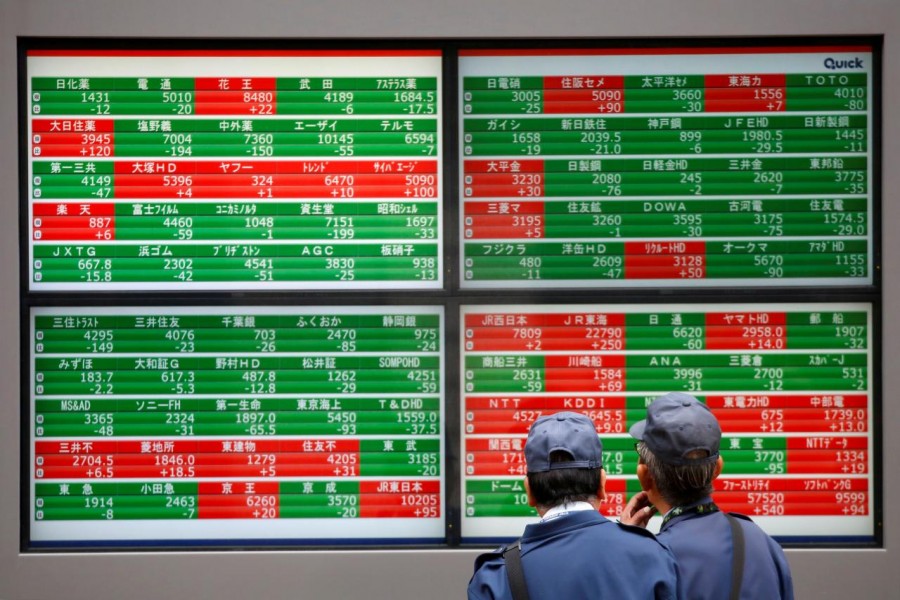Asia stocks gained on Friday after Wall Street ended volatile trade in the green, adding to the big advances of the previous session, although lingering investor jitters helped support safe-haven currencies such as the yen.
MSCI’s broadest index of Asia-Pacific shares outside Japan rose 0.3 per cent. It has fallen almost 4 per cent so far in December.
The Shanghai Composite Index edged up 0.3 per cent.
Australian stocks added 0.6 per cent and South Korea’s KOSPI climbed 0.5 per cent. Japan’s Nikkei bucked the trend and slipped 0.5 per cent, losing some steam after surging nearly 4 per cent the previous session.
US stocks roared back to end in positive territory on Thursday, with the Dow adding 1.14 per cent, after suffering steep losses for much of the session.
The gains come a day after Wall Street indexes posted their biggest daily per centage increases in nearly a decade following a sharp plunge at the week’s start.
However, all three US major indexes remain down more than 9 per cent for December following losses earlier in the month, when factors including concerns over the US-China trade war, slowing global growth and wariness toward the Federal Reserve’s tightening cycle took a heavy toll.
“Selling pressure on U.S. equities is beginning to dissipate, but the VIX index is still around 29 with investor risk sentiment still recovering. A renewed market slide remains a risk,” said Junichi Ishikawa, senior FX strategist at IG Securities in Tokyo.
The CBOE Volatility Index rose midweek to 36, its highest level since early February. It has since pulled back below 30 but remains well above a recent low of 15 marked at the beginning of December.
Focus turned to the Fed’s stance and whether the equity markets can sustain their recovery at the start of the new year.
“If Fed officials - notably Chairman (Jerome) Powell and New York Fed Governor Williams - show a cautious stance toward further rate hikes given recent instability in the stocks markets, that would lead to a rise in U.S. equities and Treasury yields, and a firmer dollar,” said Masafumi Yamamoto, chief forex strategist at Mizuho Securities in Tokyo.
Fed Chairman Powell is due to speak on January 4.
While stocks showed signs of recovery, lingering market volatility helped keep safe-haven currencies such as the yen and Swiss franc in demand.
The dollar extended overnight losses and was down 0.2 per cent at 110.74 yen. It was on track to lose more than 2 per cent this month.
The greenback declined 0.25 per cent to 0.9852 francs per dollar after slumping more than 0.8 per cent the previous day. The US currency has fallen 1.1 per cent against its Swiss peer on the month.
The euro was a shade higher at $1.1447 after gaining 0.7 per cent overnight. The common currency was headed for a 1 per cent gain in December.
The 10-year US Treasury note yield was up 3 basis points at 2.773 per cent, pulling back from a nine-month low of 2.720 per cent brushed earlier in the week.
The yield had climbed to a seven-year peak of 3.26 per cent in October as the debt market braced for potentially faster pace of Fed rate hikes in 2019.
Oil prices remained choppy, with US crude futures up 2.5 per cent at $45.73 per barrel after sliding 3.5 per cent the previous day.
US crude had rallied 8 per cent midweek after dropping to a 1-1/2-year low of $42.36 at the week’s start.
Crude has lost more than a third of its value since the beginning of October and is heading for declines of more than 20 per cent in 2018, according to Reuters news agency.
In addition to oversupply concerns, worries about slowing global economic growth have dampened investor demand for riskier asset classes and pressured crude. [O/R]
Brent crude climbed 2 per cent to $53.23 per barrel after losing more than 4 per cent the previous day.
Spot gold, which has benefited this week from the global market turmoil stood little changed at $1,277.43 an ounce following an ascent to a six-month high of $1,279.06 on Wednesday.


